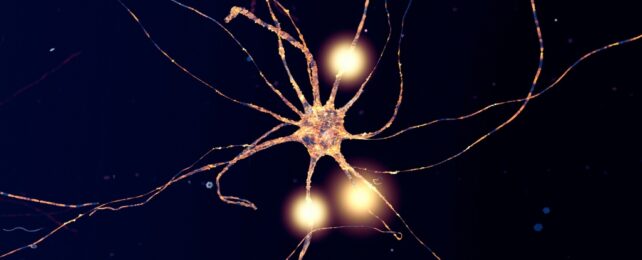Similar genetic changes in two different types of brain cells may contribute to cognitive impairment in schizophrenia and aging.
US researchers examined gene expression in more than a million brain cells collected post-mortem from 191 donors. Those with schizophrenia and older adults were found to have a comparitively reduced expression of specific genes in both neurons and supporting cells called astrocytes.
"Science often focuses on what genes each cell type expresses on its own," explains Steve McCarroll, a genomic neurobiologist from the Broad Institute of MIT and Harvard.
"These cell types are not acting as independent entities, but have really close coordination. The strength of those relationships took our breath away."
The scientists named these synchronized changes – involved in 'communication hubs' called synapses – the Synaptic Neuron and Astrocyte Program (SNAP). Now that we know SNAP exists, we may be able to develop ways to protect cognitive abilities and treat decline in aging and schizophrenia.
"Our results suggest that these relationships between schizophrenia and aging arise from shared cellular and molecular changes," the authors write.
To look closely at how our brains naturally vary, McCarroll and colleagues used single-nucleus RNA sequencing and trained an artificial intelligence model to examine gene activity in individual cells.
"To detect coordination between astrocytes and neurons in schizophrenia and aging, we needed to study tissue samples from a very large number of individuals," says neuroscientist Sabina Berretta from the Broad Institute, a co-senior author along with McCarroll.
They looked at cells from the prefrontal cortex of 94 people with schizophrenia and 97 people without the condition between the ages of 22 and 97. This brain area plays a role in various complex cognitive processes and executive functions.
They found that when neurons turned up the activity of genes related to synapses, astrocytes joined in and started activating the expression of the specific SNAP group of genes. And this activity was coordinated when genetic expression was reduced too.
In the past, studies have found that astrocytes control genes responsible for making cholesterol, which is crucial for synapse construction. Reduced cholesterol production has been seen in mouse models of brain disorders that involve cognitive decline and structural changes in the brain.
"Science has long known that neurons and synapses are important in risk for schizophrenia," explains first author Emi Ling, a neuronal biologist at the Broad Institute.
"But by framing the question a different way – asking what genes each cell type regulates dynamically – we found that astrocytes too are likely involved."
They discovered that SNAP varies among healthy young people too, either increasing or decreasing expression, but it is always coordinated between both astroctyes and neurons. In many older adults, including those with and without schizophrenia, SNAP decreased significantly.
The brain clears out old synapses and forms new ones, which is thought to make our brains more adaptable, and research has linked schizophrenia risk to genes that contribute to synaptic function.
It's also known that genetic risk for schizophrenia is linked to decreased cognition in older people, and having schizophrenia raises a person's chances of developing dementia later in life.
Like many neurological conditions, schizophrenia's root causes are complex and not clear, though multiple genetic, environmental, and biological factors appear to be involved.
The long-term symptoms, such as hallucinations and cognitive issues, frequently appear in early adulthood. Current medications primarily treat hallucinations, so we need treatments for other symptoms of the debilitating disorder.
The hope is that finding factors or therapies that boost SNAP can alleviate cognitive symptoms in schizophrenia patients and help the general population maintain cognitive function in older age.
The researchers are studying whether bipolar disorder, depression, and other conditions have similar changes and plan to look at SNAP in more brain regions.
The research has been published in Nature.
